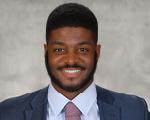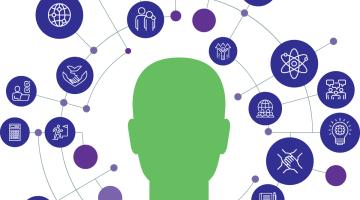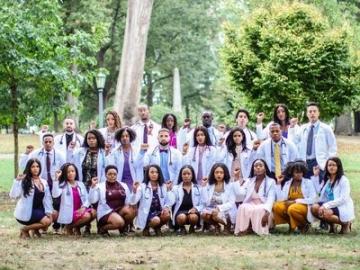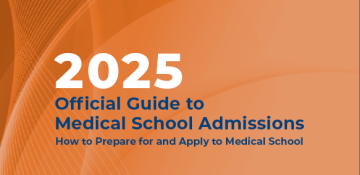New section
"Don't underestimate the importance of building connections and developing a sustainable network. Sometimes all it takes is one advocate in your corner to get you that secondary, interview, or even an acceptance! Always put your best foot forward!"

Med School: Howard University College of Medicine (HUCM)
Expected Graduation Year: 2022
College & Major: Howard University, Major in Biology, Minor in Chemistry, magna cum laude, 2017
Editor’s Note: The opinions expressed in this article are those of the author and do not necessarily reflect the opinions, positions, or the polices of the AAMC or its members.
New section
Background
- A native of Memphis, Tennessee, Jarrett’s desire to pursue a career in medicine began during his childhood.
- A mentor and HUCM alum, Dr. Neal Beckford, whom Jarrett met while shadowing his practice during high school encouraged his pursuit of medical school.
- As an undergraduate student, Jarrett intentionally sought out volunteer and research opportunities and participating in multiple development and research-focused programs including SHPEP, the Health Careers Opportunity Program, the AMGEN Scholars program, and the Louis Stokes Alliance for Minority Participation Program, among others.
- Jarrett embarked on a glide year after graduating magna cum laude from Howard University in 2017. During that time, he worked on NIH-funded research which he continued during medical school.
MCAT® Score/GPA/Coursework
Jarrett Jackson’s pursuit of changing the world through medicine began long before he stepped foot onto Howard’s campus. A native of Memphis, Tennessee, Jarrett grew up knowing he wanted to be a doctor, saying, “I’ve always had an interest in pursuing medicine. It was the first career choice of mine as a kid, even though I didn’t know the full extent of what it entailed.” Jarrett would begin building knowledge about the field by seeking out opportunities to shadow doctors, a practice that he credits with consistently nurturing his interest in the profession. Shadowing multiple doctors also taught Jarrett the value of identifying mentors continually along on his pathway to medical school.
In 2013, Jarrett Jackson entered Howard University, the internationally renowned, Historically Black university in the Nation’s capital, with goals of preparing for pursuing a career in medicine. He excelled in his coursework as a biology major and chemistry minor and gained skills in and outside of the classroom as a researcher, peer mentor, tutor, and student leader. He was able to transition from a premed at Howard to a medical student in fall 2018 after taking a glide/gap year. Now as a third-year medical student, he reflects on his journey and how he prepared for where he is today. “While at Howard, I was involved in many extracurricular activities and research programs,” he shared. “I did my best to compile a comprehensive and well-rounded application that addressed medically relevant activities that were important to me.”
When Jarrett was ready to focus on the medical school application process, he and his advisor had several conversations about his career interests in medicine and his passion for giving back to the community. Jarrett knew that an important first step, to better prepare for later stages of the process would be to self-assess his academic performance. “I had two or three C’s on my transcript, but I used those grades as an opportunity to talk about setbacks and the ways I overcame obstacles to still finish my undergraduate coursework with a strong, competitive GPA,” he said.
Ultimately, Jarrett’s academic record reflected that he was indeed ready for the rigors of medical school, as noted by Celia Williams-Fowlkes, Director of Admissions at Howard University, “Jarrett applied with a 3.62 BCPM (GPA comprised of Biology, Chemistry, Physics and Math coursework), which is above the College of Medicine’s 3.30 BCPM average GPA 5-year trend for matriculants to our program. The Admissions Committee had no concerns about his ability to handle the curriculum since those courses are the foundation on which our curriculum was built.”
Experiences
When he was a high school student, Jarrett met with Dr. Neal Beckford, a longtime friend of his grandfather and graduate of Howard University’s College of Medicine. After listening to Jarrett’s goals, Dr. Beckford offered him his first physician-shadowing opportunity. According to Jarrett, “He allowed me to shadow him from when I was a high school student all the way through college. Whenever I was home for break, I would make sure to stop by his office and shadow, even if only for a few days. He is the reason I want to pursue a career in Otolaryngology.” Jarrett credits this experience with teaching him the importance of the patient-physician relationship, noting Dr. Beckford’s inspiring “bedside manner,” saying, “He was able to effectively communicate and reassure them, while simultaneously providing them with important medical information.”
As an undergraduate, Jarrett had the benefit of a variety of mentors ranging from older students to faculty and staff. He participated in volunteer opportunities that engaged and supported other students and the community outside of campus. His prehealth advisor and mentor Julie Andrist, Director, Center for Preprofessional Education, Howard University, recalled, “Through[out] his undergraduate career at Howard University, Jarrett demonstrated a dedication to give back while challenging himself with a demanding course load. He has been able to hold himself to a standard of excellence and achieve at high levels, not only for himself but for others as well."
Ms. Andrist notes that as a biology and chemistry tutor and peer mentor in the Pre-Professional Office for two years, “Jarrett knew how to build sincere relationships with other faculty mentors and prehealth peers. He was eager to help others … .I was always able to count on Jarrett to help his prehealth peers when they needed it. He even helped me to plan a special seminar, ‘Men in Medicine and Science,’ and recruited many of his peers to attend.”
He also frequently contributed to the Health Professions Society/MAPS’s executive board by planning and implementing events for premed students such as information sessions with visiting medical school admissions officers and application preparation/tips events.
Jarrett recalls the “inspiration and guidance” of Dr. Clarence Lee, then chair of the biology department, in shaping his road to medical school. “He was vital in establishing various pipeline and research programs at Howard that I participated in frequently,” he said. Jarrett would eventually join Dr. Mark Burke’s lab after participating in the Louis Stokes Alliance for Minority Participation Program, which was run by Dr. Lee, and work on a project that examined blood-brain-barrier permeability in HIV-infected primates during his sophomore year.
Prior to beginning his freshman year at Howard, Jarrett became involved with the Howard University Pre-Freshman Health Careers Opportunity Program. This six-week summer program provided Jarrett with a foundation in relevant coursework such as biology, chemistry, and calculus, and exposed him to the field through medical enrichment events. The program was suggested to him based on his high school performance and interest in Biology, and he found it to be a great introduction to life as a college student as it gave him academic momentum going into the school year.
Between his freshman and sophomore years in 2014, Jarrett participated in the Summer Health Professions Education Program (SHPEP) at Yale University. He learned about SHPEP from an upperclassman alumna of the program. Looking back on his experience, Jarrett highly recommended the program, as he gained connections and close friends that he remains in contact with.
Jarrett participated in multiple different programs and volunteer activities on his path to medical school:
- The AMGEN Scholars Program.
- Biology Content Advisor for the Khan Academy.
- Louis Stokes Alliance for Minority Participation Program.
- Associate Investigator with the National Heart, Lung and Blood Institute within the NIH assisting in the development of a clinical trial and screening for two years.
- The Summer Internship Program in Biomedical Research (SIP), conducting research focused on the relationship between nitric oxide and blood vessel regulation in the respiratory tract.
All the research experiences Jarrett participated in at the NIH stemmed from his initial lab. As he gained experience, program directors entrusted him with more responsibly and his involvement with multiple aspects of the lab's research goals expanded.
Jarrett also participated in two international scholarship and volunteer activities during his undergraduate years, hearing about both programs from school newsletters and word of mouth. First, he shadowed physicians during a 5-week internship period with the Atlantis project in Spain. Then, he explored his roots and ancestry, traveling to Ghana as a participant of the Young AfricanA Leadership Initiative.
After graduating in 2017, Jarrett applied for a year-long Intramural Research Training Award, allowing him to conduct biomedical research at the NIH during his gap/glide year. His research focused on the expression of various genes in both airways and blood vessel walls, and how those genes are regulated and play a role in disease processes like asthma and sickle cell anemia. “I had been involved with the NIH for summer programs in years prior,” he said. “My Principal Investigator recommended this program to me. This was a fantastic opportunity for me to grow in medicine and as a person. I thoroughly enjoyed my time [in this program]. I thoroughly recommend the Summer Internship Program in Biomedical Research website as a great place to start [looking] for NIH internships and summer programs!”
Personal Comments Essay
In his essay, Jarrett highlighted his early exposure, starting with the initial interest he developed during childhood and how his support system and network of mentors helped guide him towards his goals. “The level of significant mentorship I received was instrumental in my development, and a big reason why I continue to focus on providing mentorship now, as a medical student,” he said. That same support system assisted him through the writing process; primarily receiving feedback from his mother and a mentor who was a medical student.
Ms. Williams-Fowlkes, the Director of Admissions reflected about the resilience described, “in [Jarrett’s] personal statement. [He] discussed attending a private, all-boys high school and how his peers immediately assumed that because he was African American he was recruited to play sports or fulfill a quota, rather than for his academic strength. That assumption upset him, but rather than stewing in his disappointment, it gave him the drive to change their assumptions of his worth. Not only was Jarrett able to change their minds, but he was elected Class President his senior year and left his high school with lasting relationships with friends from all races and cultures.”
Letters of Evaluation
Jarrett’s selected writers he felt would be best able to speak to his strengths and personal characteristics in a wide range of settings. He stated, “It was important to me to have a diverse cohort of individuals. I chose my biochemistry teacher, my research lab PI at the NIH, and the chair of our biology department as my three letter writers. They all knew me pretty well, but I made sure to provide them with my resume and CV as a resource.”
Interview
By the time of his interview, Jarrett felt confident with his comprehensive application. Despite a few imperfections on his transcript, his reflection and preparation equipped him to speak about anything discussed.
To prepare, Jarrett researched commonly asked questions in medical school interviews and practiced comprehensive, well thought out answers. He also reviewed his application knowing “Anything on your application is fair game, so you should be prepared to talk about any and everything you’ve included.”
Jarrett identified his main interview strength as being well-prepared; however, he recalled a lesson learned in the interview process. “Different programs have different nuances regarding the interview day that would have been helpful to know beforehand. Also, some programs participate in Multiple Mini Interviews (MMI) which are different than traditional interviews. Do your research beforehand,” he cautions. Further, he added, “It's important to practice with a friend or family member. By practicing answering questions, you’ll become more comfortable, and it will feel more natural on the actual day. Also, come prepared with specific questions tailored to the school where you’re interviewing. Always have at least one or two questions ready.” (For more tips on how to prepare for medical school interviews, check out this AAMC article.)
Jarrett’s admissions officer recalls a lasting impression he left during the interview. She shared, “I learned that Howard University College of Medicine was also being interviewed that day in November. Jarrett exuded confidence and maturity. He was looking for a school that would challenge him, allow him to continue giving back to the community, and teach him to be culturally competent. It was important to him that his school of choice had a consistent history of producing top-notch physicians, a solid residency-matching history, and valued collaboration among their students and colleagues.”
Jarrett on Why He Chose Howard University College of Medicine
Choosing to matriculate to Howard University COM was a “natural choice,” Jarrett shared. “Because I went to Howard for undergrad, I was inherently familiar with its medical school. Since my sophomore year I had been conducting HIV research in the Department of Physiology under Dr. Mark Burke, who had been recommended to me by upperclassmen. As a result, I was both familiar and comfortable with the medical school. Howard gave me my first interview and acceptance, and they showed a genuine interest in me early on that I appreciated. The opportunity to learn and train at an institution with so much historical significance and relevance currently represented a remarkable opportunity for me to further my medical education and career goals,” he said.
Howard University College of Medicine’s clear commitment to the underserved and disadvantaged communities was key for Jarrett. Howard University Hospital serves some of the most disadvantaged patients in the District of Columbia, and about 70% of HUCM’s student body is comprised of ethnic minorities who are underrepresented in medicine in the U.S. Jarrett also mentioned the important resource of the school’s 4,000+ alumni network of Black physicians practicing in the country today.
Howard University College of Medicine on Why They Chose Jarrett
According to Ms. Williams-Fowlkes, Director of Admissions, Jarrett was an ideal candidate with high academic credentials, great experiences, service to his community and excellent letters of evaluation. He also met the mission of the school’s diversity policy. She stated, “HUCM’s diversity policy is to increase the number of African American males in our program and the medical career. With an applicant pool of over 9,000 applicants to fill 120 seats, it could be easy for applicants to get buried in our piles of applications. But Jarrett did what our most competitive applicants do to ensure his application was noticed: he submitted his application early to better his chances of his file being reviewed at the beginning of the cycle and to secure an interview with his schools of choice.”
Ms. Williams-Fowlkes considered Jarrett an ideal candidate but stressed that this does not indicate that the school looks for perfection in its applicants. She added, “I often say we are not always looking for applicants with straight A’s or a 528 on the MCAT [exam]. We are looking for intelligent, well-rounded applicants who meet our mission and students who can grow and be molded into highly competent, caring physicians with leadership skills. We look for hints of these qualities in our applicants, all of which we saw clearly in Jarrett’s application.”
New section
Highlighted Competencies
Note: This section helps to illustrate how multiple competencies can be demonstrated across many experiences, activities, and parts of your application.
Shows a commitment to something larger than oneself; demonstrates dedication to service and a commitment to making meaningful contributions that meet the needs of communities.
Being a peer mentor, tutor and student leader; participating in volunteer opportunities helped plan a seminar for his undergraduate class.
Reflected on academic weaknesses and took steps to address them.
Effectively conveys information to others using spoken words and sentences; actively listens to understand the meaning and intent behind what others say; and recognizes potential communication barriers and adjusts approach or clarifies information as needed.
Effectively communicated with patients.
Appreciates how historical, sociocultural, political, and economic factors affect others’ interactions, behaviors, and well-being; values diversity; and demonstrates a desire to learn about different cultures, beliefs, and values.
Traveled to Ghana for the Young AfricanA Leadership Initiative.
Practices continuous personal and professional growth for improvement, including setting and communicating goals for learning and development; reflects on successes, challenges, and mistakes; pursues opportunities to improve knowledge and understanding; and asks for and incorporates feedback to learn and grow.
Established research programs; participated in multiple education programs, volunteer activities, and research opportunities; worked with a mentor to develop.
Uses logic and reasoning to identify the strengths and weaknesses of alternative solutions, conclusions, or approaches to problems.
Coursework.
Applies quantitative reasoning and appropriate mathematics to describe or explain phenomena in the natural world.
Coursework, research experience.
Applies knowledge of the scientific process to integrate and synthesize information, solve problems, and formulate research questions and hypotheses; is facile in the language of the sciences and uses it to participate in the discourse of science and explain how scientific knowledge is discovered and validated.
Coursework, SHPEP, research experience.
Applies knowledge and skill in the natural sciences to solve problems related to molecular and macro systems, including biomolecules, molecules, cells, and organs.
Coursework, SHPEP, research experience, NIH internships.


